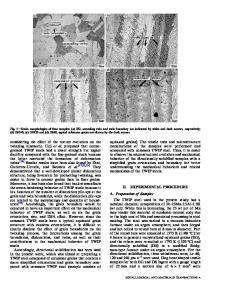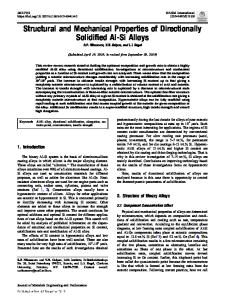Effect of magnetic field on the microstructure and macrosegregation in directionally solidified Pb-Sn alloys
- PDF / 2,793,887 Bytes
- 10 Pages / 598 x 778 pts Page_size
- 28 Downloads / 356 Views
I.
INTRODUCTION
DIRECTIONAL solidification of binary alloys in a positive thermal gradient, with melt on the top, solid below, and gravity pointing down, may produce a solutal profile in the interdendritic mushy region and in the melt immediately ahead of the cellular/dendritic array, which promotes thermosolutal convection. A systematic investigation of macrosegregation resulting from such thermosolutal convection in Pb-Sn alloys has recently been reported, t~,21 Unlike AI-Cu alloys, which produce dendrite steepling when directionally solidified at low gradients of constitutional supercooling, pm the array morphology is observed to be uniform across the sample cross section in Pb-Sn alloysJ 5j This makes it possible to measure the tip radii, especially of cells, by successively polishing longitudinal sections near quenched array tips for a quantitative comparison with theoretical models. However, theoretical models for constrained growth of cellular/dendritic arrays assume purely diffusive transport and do not include convection. The purpose of this study was to explore the possibility of using magnetic field to suppress the thermosolutal convection which is present during steady-state directional solidification of cellular/dendritic arrays in Pb-Sn alloys. The application of a magnetic field to suppress convection during directional solidification has been investigated, especially for electronic materials, t6,7,81 These studies, concerned mostly with planar liquid-solid interface, have shown that convective flows in the melt can be significantly reduced by application of magnetic fields. However, for constrained growth of cellular/dendritic arrays during directional solidification, the influence of an applied magnetic field has not been studied. Boettinger e t a l . tg~ examined the influence of transverse and axial magnetic fields in off-eutectic Pb-57 wt pct Sn alloy for growth conditions expected to produce a planar liquidsolid interface with an aligned two-phase composite microstructure. The microstructures of these alloys, S.N. TEWARI, Professor, and HUI SONG, Research Associate, are with the Chemical Engineering Department, Cleveland State University, Cleveland, OH 44115. RAJESH SHAH, formerly Graduate Student, Chemical Engineering Department, Cleveland State University, is with Agmet Metals Inc., Oakwood Village, OH 44146. Manuscript submitted February 25, 1993. METALLURGICALAND MATERIALSTRANSACTIONS A
however, contained only a small volume fraction of primary dendrites. Application of a magnetic field (0.1 T, transverse to the growth direction) had no influence on the microstructure or longitudinal macrosegregation. In this article, we examine the influence of a stronger transverse magnetic field (0.45 T) on the microstructure and macrosegregation during steady-state cellular/dendritic arrayed growth of Pb-Sn alloys. Two growth conditions, (1) where convection is due to the density profile of the interdendritic melt and (2) where convection results from the solutal buildup in the melt ahead of the arra
Data Loading...










